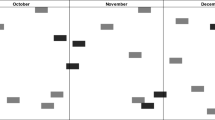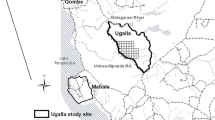Abstract
In order to estimate the genetically effective troop size of Japanese monkeys, we have to know the pattern of distribution of the numbers of gametes contributed by the individual members of the parental population to the next generation. The author inspected the observation records of macaque troops made by a number of socio-ecologists and found that the relationship between sexual rank and sexual activity of adult males could be approximately expressed by the law of geometrical series. Assuming that the genetic contribution of male parents to the next generation was proportional to their sexual activity and that the numbers of gametes contributed by the female parents formed thePoisson distribution, the author derived a formula for estimating effective troop size (N), namely,

whereN c was the census number andN m andN f the numbers of male and female parents, respectively, of the troop. Moreover, assumingN m =0.2N c andN f =0.3N c as an average, the effective size could be estimated as 36% or less of the census number.
Similar content being viewed by others
References
Buri, P., 1956. Gene frequency in small populations of mutantDrosophila.Evolution, 10: 367–402.
Carpenter, C. R., 1942. Sexual behavior of free ranging rhesus monkeys (Macaca mulatta).Jour. Comp. Psychol., 33: 143–162.
Conaway, C. H. &C. R. Koford, 1964. Estrous cycles and mating behavior in a freeranging band of rhesus monkeys.Jour. Mammal., 45: 577–588.
Crow, J. F. &N. E. Morton, 1955. Measurement of gene frequency drift in small populations.Evolution, 9: 202–214.
Furuya, Y., 1963. On the Gagyusan troop of Japanese monkeys after the first separation.Primates, 4: 116–118.
Hazama, N., 1964. Survey report on the natural Japanese monkeys in Hieizan.Yaen, 19: 21–26. (In Japanese)
Itani, J., K. Tokuda, Y. Furuya, &Y. Shin, 1963. The social construction of natural troops of Japanese monkeys in Takasakiyama.Primates, 4: 1–42.
Izawa, K. &T. Nishida, 1963. Monkeys living in the northern limits of their distruibution.Primates, 4: 67–88.
Kano, K., 1964. On the second fisson of natural troop of Japanese monkeys in Takasakiyama. In:Takasakiyama no Saru (Japanese Monkeys in Takasakiyama), Keiso Shobo, Tokyo, pp. 42–73. (In Japanese)
Kato, M., 1935. A statistical study on insects gathering around electric light.Ecol. Res., 1: 243–245. (In Japanese)
—— &K. Hori, 1952. Studies on the associative ecology of insects. V. Synecological analysis ofDrosophila association in Sendai, Japan.Sci. Rep. Tohoku Univ., 4th Series, 19: 231–237.
Kaufmann, J. H., 1965. A three-year study of mating behavior in a free-ranging band of rhesus monkeys.Ecology, 46: 500–512.
Kawai, M., 1964. Takeno troop of Japanese monkeys in Kashima Park.Yaen, 18: 14–20. (In Japanese)
Kawamura, S., 1958. The dominance hierarchy of the Minoo-B group—a study on the rank system of Japanese macaque.Primates, 1: 149–156. (In Japanese with English summary)
—— &M. Kawai, 1956. Social organization of the natural group of Japanese macaque —the case of the Minoo-B group.Jap. J. Ecol., 6: 45–50. (In Japanese with English summary)
Kerr, W. E. &S. Wright, 1954a. Experimental studies on the distribution of gene frequencies in very small populations ofDrosophila melanogaster. I. forked.Evolution, 8: 172–177.
—— & ——, 1954b. Ditto. III. aristapedia and spineless.Evolution, 8: 293–302.
Komatsu, Y., 1949.Bio-statistics, Asakura Book Co., Tokyo. (In Japanese)
Koyama, N., 1967. On dominance rank and kinship of a wild Japanese monkey troop in Arashiyama.Primates, 8: 189–216.
Loy, J., 1971. Estrous behavior of free-ranging rhesus monkeys.Primates, 12: 1–31.
Maeda, K., 1963. A new era of the Takaosan troop.Yaen, 13: 7–13. (In Japanese)
——, 1968. Social construction of Takaosan troop (I).Yaen, 31: 26–33. (In Jpanese)
Motomura, I., 1932. A statistical procedure for animal association.Zool. Mag., 44: 379–383. (In Japanese)
——, 1935.Ostrea speciosa association at Moroiso, Misaki district.Ecol. Res., 1: 55–62. (In Japanese)
Nakajima, K., 1958. Natural troop of Japanese monkeys in Arashiyama.Yaen, 1: 18–22. (In Japanese)
Nishida, T., 1966. A sociological study of solitary male monkeys.Primates, 7: 141–204.
Nozawa, K., 1956. A statistical study on the natural population of genusDrosophila.Jap. J. Ecol., 6: 1–6. (In Japanese with English summary)
——, 1957. Statistical studies on the populations of farm animals. I. Estimation of the effective population size.Proc. Japan Acad., 33: 217–220.
——, 1963. Competition between brown gene and its wild-type allele inDrosophila melanogaster. II. Estimations of relative viability of brown homozygote and an analysis of changes in gene-frequency.Jap. J. Genet., 38: 6–20.
——, 1964. Animal breeding and biometrical genetics. Problems of inbreeding in dairy cattle population of Japan.Recent Adv. Breeding Res., 5: 28–36. (In Japanese)
——, 1970. Estimation of the effective size inDrosophila experimental populations.DIS, 45: 117–118.
——,T. Tomita, K. Esaki, J. Hayakawa, J. Bito, &K. Kondo, 1962. The breeding structure and effective population size of Kiso native horses.Jap. J. Zootech. Sci., 33: 160–164. (In Japanese with English summary)
Shinozaki, K., 1955. Notes on the law of geometric series.Physiol. & Ecol., 6: 127–144. (In Japanese with English summary)
—— &N. Urata, 1953. Apparent abundance of different species and heterogeneity.Res. Popul. Ecol., 2: 8–21. (In Japanese with English summary)
Sugiyama, Y., 1960. On the division of a natural troop of Japanese monkeys at Takasakiyama.Primates, 2: 109–148.
Suzuki, A. 1965. An ecological study of wild Japanese monkeys in snowy areas—focused on their food habit.Primates, 6: 31–72.
—— &K. Wada. 1964. Japanese monkeys in Jigokudani, Shiga height.Yaen, 16/17: 9–17. (In Japanese)
Tanaka, A., 1948. Population density of mountaneous rats and mice andMotomura's law of geometrical series.Kagaku, 18: 371–372. (In Japanese)
Tokuda, K., 1959. Provisionalization of monkeys in a natural habitat in Shikoku.Yaen, 4: 3–6. (In Japanese).
——, 1961–2. A study on the sexual behavior in the Japanese monkey troop.Primates, 3: 1–40.
Tsumori, A., 1966. Delayed response of wild Japanese monkeys by the sand-digging method (II).Primates, 7: 363–380.
——, M. Kawai, &R. Motoyoshi, 1965. Ditto. (I)Primates, 6: 195–212.
Utida, S., 1943. Some considerations onMotomura's law of geometrical series of population density in animal association.Ecol. Res., 9: 173–178. (In Japanese)
Wright, S., 1931. Evolution in Mendelian populations.Genetics, 16: 97–159.
——, 1938. Size of population and breeding structure in relation to evolution.Science, 87: 430–431.
—— &W. E. Kerr, 1954. Experimental studies of the distribution of gene frequencies in very small populations ofDrosophila melanogaster. I. Bar.Evolution, 8: 172–177.
Yamada, M., 1966. Five natural troops of Japanese monkeys in Shodoshima Island. (I) Distribution and social organization.Primates, 7: 315–362.
Author information
Authors and Affiliations
About this article
Cite this article
Nozawa, K. Population genetics of Japanese monkeys: I. Estimation of the effective troop size. Primates 13, 381–393 (1972). https://doi.org/10.1007/BF01793658
Received:
Accepted:
Issue Date:
DOI: https://doi.org/10.1007/BF01793658




